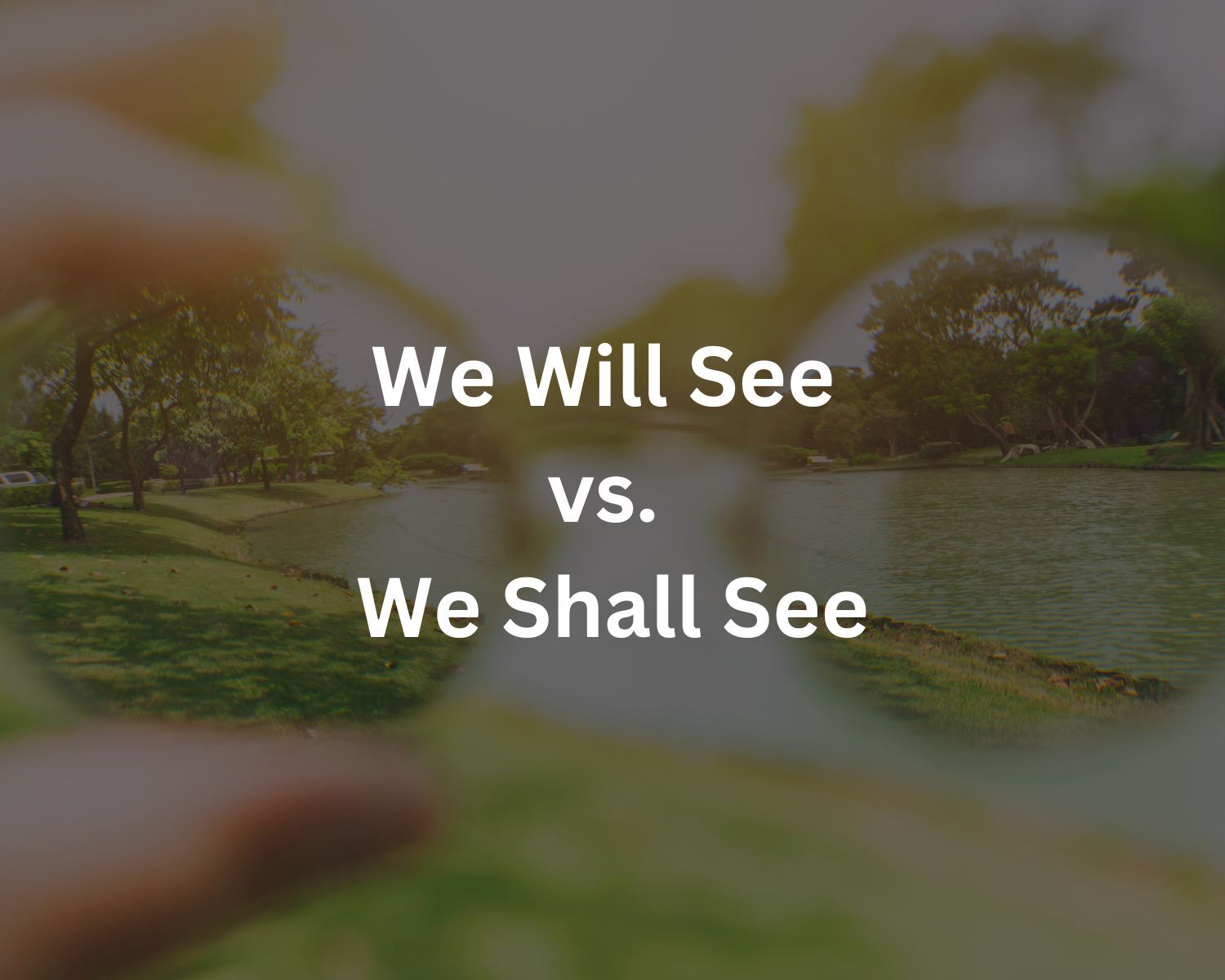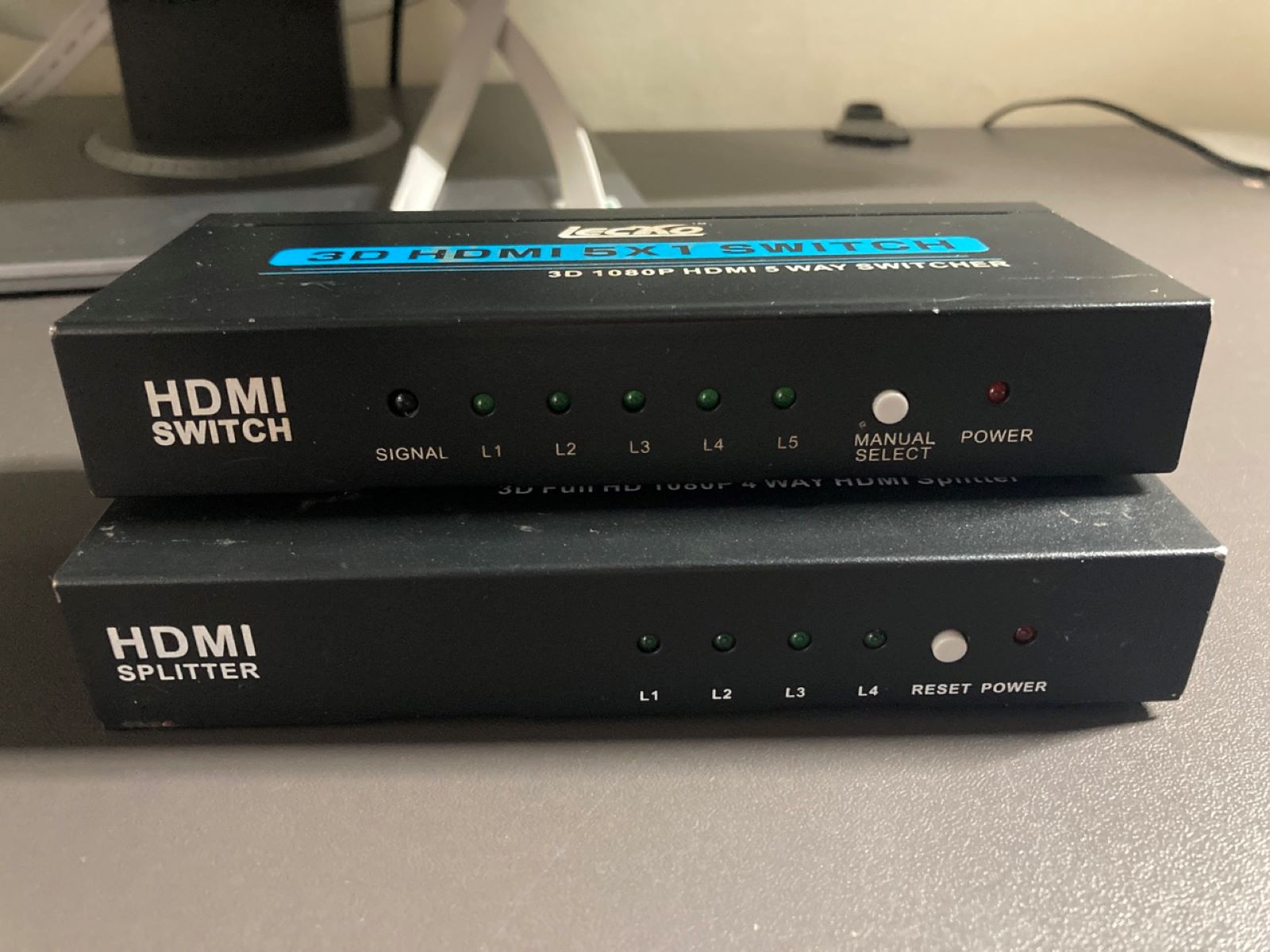Home>Language and Grammar>The Key Difference Between ‘We Will See’ And ‘We Shall See’


Language and Grammar
The Key Difference Between ‘We Will See’ And ‘We Shall See’
Published: January 27, 2024
Learn the key difference between 'We Will See' and 'We Shall See' in language and grammar. Understand the nuances to use them correctly. Discover more!
(Many of the links in this article redirect to a specific reviewed product. Your purchase of these products through affiliate links helps to generate commission for Regretless.com, at no extra cost. Learn more)
Table of Contents
Introduction
The phrases "we will see" and "we shall see" are commonly used in everyday conversations, often serving as a prelude to uncertain outcomes or future events. While these expressions may appear interchangeable at first glance, a closer examination reveals subtle differences in their connotations and usage. Understanding the nuances between these two phrases can enrich our communication skills and enhance our ability to convey subtle shades of meaning in various contexts.
In the following sections, we will delve into the definitions of "we will see" and "we shall see," explore their distinct connotations, and examine their cultural and regional variations. By the end of this exploration, you will gain a deeper appreciation for the intricacies of language and the impact of these subtle linguistic choices on our interactions. Let's embark on this linguistic journey to unravel the key differences between "we will see" and "we shall see" and discover how these seemingly similar phrases can shape the tone and implications of our conversations.
Definition of "We Will See"
"We will see" is a common phrase used in the English language to express a sense of uncertainty or anticipation regarding future events or outcomes. The phrase is formed by combining the first-person plural pronoun "we" with the modal verb "will" and the verb "see." The use of the modal verb "will" in this context indicates a future tense, suggesting that the outcome or resolution of a situation will become apparent over time.
When someone says "we will see," it can convey a sense of cautious optimism, acknowledging the uncertainty of what lies ahead while expressing a willingness to wait and observe how events unfold. This phrase often implies a sense of openness to the possibilities that may arise, without making definitive predictions or commitments. It reflects a mindset of adaptability and a willingness to embrace the unfolding of events, allowing for flexibility in response to the outcomes.
In everyday conversations, "we will see" is frequently employed in response to inquiries about future plans, decisions, or anticipated developments. It can be used to convey a non-committal stance while leaving room for potential changes or developments. Additionally, the use of "we" in the phrase suggests a collective perspective, indicating that the outcome will be observed or experienced together by the individuals involved.
The phrase "we will see" is often used to acknowledge the unpredictability of the future, recognizing that circumstances may evolve in unforeseen ways. It reflects a mindset of patience and readiness to adapt to the unfolding events, embracing the uncertainty with a sense of curiosity and open-mindedness.
In summary, "we will see" encapsulates a sense of anticipation and openness to future possibilities, acknowledging the unpredictability of events while maintaining a flexible and observant stance. This phrase serves as a linguistic tool to convey a nuanced approach to uncertain outcomes, embodying a blend of optimism, caution, and adaptability in the face of the unknown.
Definition of "We Shall See"
"We shall see" is a phrase deeply rooted in the English language, carrying a sense of anticipation and uncertainty regarding future events or outcomes. This expression combines the first-person plural pronoun "we" with the modal verb "shall" and the verb "see." The use of the modal verb "shall" in this context conveys a sense of determination or inevitability, suggesting that the resolution or unfolding of a situation will become apparent over time.
When someone utters "we shall see," it carries an undertone of confident expectation, acknowledging the uncertainty of what lies ahead while expressing a firm belief in the eventual revelation of the outcome. Unlike "we will see," which implies a more open-ended and flexible approach, "we shall see" conveys a sense of conviction and assurance that the truth or resolution will manifest as events unfold.
In everyday discourse, "we shall see" is often used to convey a sense of unwavering confidence in the eventual clarity or realization of a situation. It can be employed in response to inquiries about future plans, decisions, or anticipated developments, reflecting a steadfast belief in the inevitability of the outcome. The use of "we" in the phrase signifies a collective perspective, indicating that the individuals involved will witness or experience the unfolding events together.
The phrase "we shall see" encapsulates a sense of unwavering anticipation and confidence in the eventual revelation of the truth or outcome, acknowledging the uncertainty of the future while maintaining a resolute and assured stance. This expression serves as a linguistic tool to convey a determined approach to uncertain outcomes, embodying a blend of confidence, anticipation, and conviction in the face of the unknown.
In summary, "we shall see" conveys a sense of unwavering anticipation and confidence in the eventual revelation of the truth or outcome, acknowledging the uncertainty of the future while maintaining a resolute and assured stance. This expression serves as a linguistic tool to convey a determined approach to uncertain outcomes, embodying a blend of confidence, anticipation, and conviction in the face of the unknown.
Usage of "We Will See"
The phrase "we will see" is commonly employed in various contexts to convey a sense of uncertainty, anticipation, and open-mindedness regarding future events or outcomes. This versatile expression is frequently utilized in everyday conversations, discussions, and decision-making processes, reflecting a nuanced approach to navigating the unpredictability of the future.
In interpersonal communication, "we will see" often serves as a response to inquiries about future plans, potential outcomes, or pending decisions. When used in this context, it signifies a willingness to embrace the unfolding events with an open mind, acknowledging the inherent uncertainty while maintaining a sense of optimism. This phrase allows individuals to adopt a flexible and observant stance, recognizing that the course of events may evolve in unforeseen ways.
Furthermore, "we will see" can be employed in professional settings during deliberations, negotiations, or strategic planning. Its usage in business contexts reflects a pragmatic and adaptable approach to addressing uncertainties and potential outcomes. By utilizing this phrase, individuals and teams acknowledge the dynamic nature of business environments, demonstrating readiness to navigate unforeseen developments with a receptive mindset.
In the realm of decision-making, "we will see" embodies a balanced perspective that accommodates the possibility of multiple outcomes. It conveys a sense of cautious optimism, encouraging a collaborative and open-ended approach to exploring potential solutions or courses of action. This phrase empowers individuals to maintain a sense of adaptability and resilience in the face of uncertainty, fostering an environment conducive to creative problem-solving and strategic decision-making.
Moreover, in social interactions, "we will see" can be utilized to express a non-committal yet optimistic outlook, particularly when discussing future plans, events, or opportunities. Its usage reflects a respectful acknowledgment of the unknown, allowing for the organic unfolding of events while maintaining a positive outlook on the potential outcomes.
In essence, "we will see" serves as a linguistic tool to convey a nuanced and open-minded approach to uncertain outcomes, encapsulating a blend of optimism, caution, and adaptability. Its versatile usage across various contexts underscores its significance as a means of embracing the unpredictability of the future with a receptive and resilient mindset.
Usage of "We Shall See"
The phrase "we shall see" holds a distinct place in the English language, embodying a sense of unwavering anticipation and confidence in the eventual revelation of truth or outcomes. Its usage extends across various contexts, reflecting a steadfast belief in the inevitability of events and a determined approach to navigating uncertainties.
In interpersonal communication, "we shall see" often serves as a response to inquiries about future plans, potential outcomes, or pending decisions. When employed in these exchanges, it conveys a sense of resolute anticipation, acknowledging the uncertainty of the future while maintaining a confident and assured stance. This phrase allows individuals to express their unwavering belief in the eventual clarity or resolution of a situation, fostering an environment of steadfast determination and conviction.
Furthermore, "we shall see" can be utilized in professional settings during discussions, strategic planning, or negotiations. Its usage in business contexts reflects a resolute and assured approach to addressing uncertainties and potential outcomes. By employing this phrase, individuals and teams convey a sense of unwavering confidence in navigating unforeseen developments, fostering an environment conducive to decisive and determined decision-making processes.
In the realm of decision-making, "we shall see" embodies a sense of unwavering conviction and assurance, encouraging a steadfast belief in the eventual manifestation of truth or outcomes. This phrase empowers individuals to maintain a resolute and confident stance in the face of uncertainty, fostering an environment conducive to decisive and determined actions.
Moreover, in social interactions, "we shall see" can be utilized to express a confident and assured outlook, particularly when discussing future plans, events, or potential opportunities. Its usage reflects a steadfast acknowledgment of the unknown, allowing for the organic unfolding of events while maintaining a resolute and assured perspective on the eventual outcomes.
In essence, "we shall see" serves as a linguistic tool to convey a determined and confident approach to uncertain outcomes, encapsulating a blend of assurance, conviction, and unwavering anticipation. Its versatile usage across various contexts underscores its significance as a means of embracing the unpredictability of the future with a resolute and confident mindset.
Differences in Connotation
The phrases "we will see" and "we shall see" exhibit subtle yet significant differences in connotation, reflecting distinct shades of meaning and underlying attitudes toward uncertain outcomes.
When using "we will see," there is a sense of cautious optimism and open-mindedness. This phrase conveys a willingness to embrace the unfolding events with a receptive mindset, acknowledging the unpredictability of the future while maintaining a sense of adaptability. It reflects a balanced perspective that accommodates the possibility of multiple outcomes, allowing for a flexible and observant approach to navigating uncertainties. "We will see" embodies an attitude of curiosity and readiness to adapt to the evolving circumstances, fostering an environment conducive to creative problem-solving and strategic decision-making.
In contrast, "we shall see" carries an undertone of confident expectation and unwavering assurance. This phrase conveys a steadfast belief in the eventual revelation of truth or outcomes, reflecting a resolute and assured stance in the face of uncertainty. It embodies a sense of determination and conviction, fostering an environment conducive to decisive actions and unwavering confidence in navigating unforeseen developments. "We shall see" empowers individuals to maintain a resolute and confident outlook, acknowledging the unknown while expressing a firm belief in the inevitability of the outcome.
These nuanced differences in connotation shape the tone and implications of conversations, influencing the overall atmosphere and attitudes toward uncertain future events. While "we will see" embraces adaptability and open-mindedness, "we shall see" exudes confidence and unwavering anticipation. Understanding these subtle connotative distinctions enriches our communication skills, enabling us to convey nuanced attitudes and perspectives in various contexts.
Cultural and Regional Variations
The phrases "we will see" and "we shall see" not only exhibit differences in connotation but also demonstrate intriguing cultural and regional variations in their usage. These variations offer valuable insights into the diverse linguistic nuances and attitudes toward uncertain outcomes across different cultural and geographical contexts.
In certain cultures, the usage of "we will see" may align with a collective mindset that embraces flexibility and adaptability in the face of uncertainty. This expression of cautious optimism reflects a willingness to navigate unforeseen developments with an open mind, fostering an environment conducive to collaborative problem-solving and decision-making. In contrast, cultures that emphasize decisiveness and unwavering confidence may lean toward the usage of "we shall see." This phrase embodies a resolute belief in the inevitability of outcomes, reflecting a cultural inclination toward assertiveness and determination in navigating uncertainties.
Regional variations also play a significant role in shaping the usage of these phrases. In some regions, the preference for linguistic expressions that convey a sense of patient observation and adaptability may lead to a higher frequency of "we will see" in everyday conversations. This reflects a cultural inclination toward embracing the unpredictable nature of the future with a receptive and open-minded approach. Conversely, in regions where the linguistic landscape is characterized by a strong emphasis on conviction and unwavering confidence, the usage of "we shall see" may be more prevalent. This reflects a cultural tendency to express resolute anticipation and confidence in the eventual revelation of outcomes, shaping the overall tone of interactions and decision-making processes.
Moreover, within specific linguistic communities, the historical and literary usage of these phrases may contribute to their cultural connotations. The portrayal of these expressions in literature, media, and cultural narratives can influence their perceived meanings and implications, further shaping their usage within distinct cultural and regional contexts.
These cultural and regional variations highlight the dynamic nature of language and its profound influence on the attitudes and approaches toward uncertain outcomes. By recognizing and appreciating these nuanced differences, individuals can navigate cross-cultural communications with sensitivity and understanding, fostering meaningful interactions and mutual respect across diverse linguistic landscapes.
Conclusion
In conclusion, the exploration of the phrases "we will see" and "we shall see" unveils a rich tapestry of linguistic nuances, cultural variations, and connotative distinctions. These seemingly similar expressions carry subtle yet significant differences in their usage, connotations, and regional interpretations, reflecting the diverse attitudes and approaches toward uncertain outcomes within the English language.
"We will see" encapsulates a sense of cautious optimism, open-mindedness, and adaptability, fostering an environment conducive to flexible decision-making and collaborative problem-solving. This phrase embodies a balanced perspective that accommodates the unpredictability of the future, allowing for a receptive and observant approach to navigating uncertainties.
On the other hand, "we shall see" conveys unwavering anticipation, confidence, and resolute assurance, reflecting a determined approach to embracing the unknown. It embodies a steadfast belief in the inevitability of outcomes, fostering an environment conducive to decisive actions and unwavering confidence in navigating unforeseen developments.
Furthermore, the cultural and regional variations in the usage of these phrases provide valuable insights into the diverse linguistic landscapes and attitudes toward uncertain outcomes. The prevalence of "we will see" in cultures that emphasize adaptability and patient observation contrasts with the inclination toward "we shall see" in regions where assertiveness and unwavering confidence shape linguistic expressions.
By recognizing and appreciating these linguistic subtleties and cultural nuances, individuals can navigate cross-cultural communications with sensitivity and understanding, fostering meaningful interactions and mutual respect across diverse linguistic landscapes.
In essence, the key difference between "we will see" and "we shall see" lies in their connotations, reflecting a spectrum of attitudes from cautious optimism to resolute assurance. Understanding these distinctions enriches our communication skills, enabling us to convey nuanced perspectives and embrace the unpredictability of the future with adaptability and unwavering confidence.














